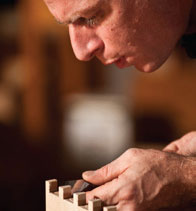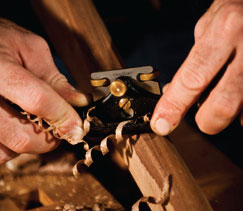This interview was originally published in the SustainLife Journal of the Ploughshare Institute, our “parent” organization. See the original article here.
Q. Ploughshare: How did you first get started with woodworking?
A. Frank: My first recollection of woodworking was when my mom bought me an old eggbeater drill at a junk shop. I was seven years old at the time, and I don’t even remember if it worked. I was fascinated with woodworking.
When I was ten and eleven years old, I began to take classes from a man named Mark Schwennesen, whom I would later apprentice under. Then when I was twelve, that was in 1988, our community had our first annual Craft Fair. The men in our community who taught the class asked each of us what we wanted to build. I chose a blanket chest, with lots and lots of dovetails. It was probably a bit much to bite off, but with a lot of help and a lot of work, I was able to make a dovetailed blanket chest of solid cedar. Around this time, I remember one of the men in our community telling me he felt like I had a gift for furniture making. This was one of those times in my life that gave me a new and clearer focus on what I should pursue.
When I was seventeen, I started an apprenticeship under Mark Schwennesen in Austin, Texas. We built all kinds of furniture. For the first year or so, I just built furniture with Mark; I didn’t build my own pieces. I worked alongside him and did whatever tasks he wanted me to do, whether it was gluing boards up or sweeping the floor or holding a piece of wood. In that first year, I learned an incredible amount because I didn’t even know how a piece of furniture went together, but after just being there, working on the pieces that he was working on, I learned how an armoire went together, or a dresser, or other types of furniture. It was amazing how much I learned just in that first year.
After having apprenticed for three or four years, I served as a journeymen at our shop here in Waco. That was also a really good experience because traditionally, a journeyman would go to another place, as the name implied. He would journey from his apprenticeship to another place, and he would learn from other craftsmen because different craftsmen have different ways of working. And so, after Mark Schwennesen had established for me a solid foundation of skills, skills I still adhere to this day, I began my journeymanship. I learned new skills and different ways of working that enhanced my woodworking skills further.
Q. What do you feel are the most important things for your beginning woodworking students to learn?
A. Well, I think that when somebody first goes into woodworking, it can be pretty daunting. They have a lot of questions, like: “How am I going to prepare this wood?” “How am I going to cut this joint?” “Do I need all these machines?”
What a lot of beginning woodworkers do (along with most woodworkers, in general) is set up a mini-factory in their garage, with lots of machines and such. Here, our focus is primarily on hand tools. I try to encourage people that with a small set of hand tools and a good work bench, you can produce quite a bit. The first thing we teach students is how to sharpen their tools because without sharp tools, it’s impossible to do hand-tool woodworking. A lot of people don’t realize what sharp is until they actually use a sharp tool. In our classes the students can see and experience firsthand the difference between a dull tool and a sharp one and also learn how to keep their tools sharp.
It’s important to have a basic, good set of tools, a good bench and foundational hand skills. To start with those foundational hand skills is so, so important.
Q. Can you elaborate on which hand skills are the most important for beginning students?
A. It’s very important for young people to work with their hands because it teaches them hand-eye coordination. It teaches them to be able to work in three dimensions. Nowadays, people are so stuck in a two dimensional, virtual world that they don’t even, they can’t even, experience working with their hands—they don’t have the ability to shape a piece of wood. Even woodworking is today moving toward “virtual woodworking,” both in what people write about it and also in the use of computer-controlled machines. They’re making CNC machines now for the home shop, so you can draw something up on your computer and then send it to the machine, and it’ll produce whatever you want, something carved or whatever.
I think that one advantage of working with hand tools is that it slows down the learning process so that you can really learn the skills, skills like how to shape wood, how to plane wood and how to saw. Sawing is a skill that is difficult to learn at first, but after you learn the right techniques, you can saw accurately and quickly.
Q. What are your goals as a teacher?
A. My goals as a teacher are to try to inspire and impart skills to the students. I want to
be able to not only impart the skills, so that they can then take these skills home and use them, but I also want to inspire students that they really can do it, it’s not just a mystery, it’s not something impossible. And through the different exercises we teach, we’re able to impart those skills necessary for them to be able to do whatever projects they want to do.
One of the things that I enjoy most about teaching is seeing the excitement in the students, seeing students who have never done woodworking, or have done very little, actually go through the course and, in the end, be able to complete a project. And we’re talking about people that don’t normally work with their hands at all. There are all kinds of professional people who are very good at what they do, but in their line of work, they don’t work with their hands to create things, so at the end of the day, they can’t say, “I’ve actually made this.” So when
they take a class and learn to do just that, I think they feel a real sense of accomplishment.
Q. What do your students seem to like the most about your classes?
A. Like I was just saying, it’s being able to make something with their own hands, being able to create something and at the end of the day, being able to feel the satisfaction that they get from that.
There is also something pretty satisfying about having some tool that they’ve bought, and maybe tried to use; they’ve wrestled with how to use it, and then they come to class, learn how to sharpen it and then take a shaving off for the first time. They hear that wisping sound as they plane the wood, and they say, “The class was worth it just for that!” That’s always pretty exciting. You know that they just “got it,” and they’re excited about it. Their tools actually work, and now they’re making things with their tools.
Q. Can you elaborate on why you have more of a hand tool focus?
A. Working with hand tools really does slow down the process to where you can understand how the tools work and how the joints work. It gives you greater sensitivity to your work because when you’re working with a machine, a lot of times you’re disconnected from your work. You’ve got on all the safety equipment—ear protection, eye protection, dust protection—which tends to disconnect you from what you’re doing. You don’t experience it the same way as you can with hand tools.
When I’m working with a hand tool, there’s a whole different feeling. When I teach woodworking, I try to get students to listen to the sound of the plane when it’s going through the wood. They learn to feel how much or how little pressure to apply. They have to look, and see, “Oh, the shaving’s thicker on this side, and it’s not as thick on this side.” They have to feel the blade protruding. “Is it coming out more on this side?” So I also want to inspire the student that they really can do it, that it’s not just a mystery. They’re using their senses. They’re smelling the wood; they’re experiencing it. You get to experience the work in a totally different way, a way that you don’t with power tools.
And what’s interesting is, a lot of times, people have a misconception about hand tools: that it’s a slow, archaic way of doing things. It’s not that hand tools didn’t work, but they just didn’t keep pace with the industrialization of society. So hand tools slowly fell by the wayside, and power tools took their place. And also, what a lot of woodworkers do is set up a mini-factory in their garage. But I find that many students say, “This is what I want to do. Hand tools are just so much more enjoyable”. You can do that in a small space, and it’s safe. You can still get cut with a hand tool, but it’s going to be far less severe than if you were to get cut with a machine.
A couple of weeks ago, we had a workbench class, and one of my students was hand planing the top of his workbench. Just imagine, this is a hard maple top, and it’s 31 inches wide and seven feet long, and he’s been planing it for quite some time. Someone walks in and says to him, “Well, what is that? That probably takes at least twice as long to do it by hand doesn’t it?” And I kind of just laughed inside because he’s missing the whole concept here. There are some things that the best way to them is by hand. All woodworking can be done totally by hand. Only part of it even can be done with a machine. If your aim is to mass produce something, it may be worth it to set up a machine that can efficiently mass produce it, but the finest pieces of furniture that were ever built during the seventeenth, eighteenth and nineteenth centuries were done entirely by hand.
I don’t mind using power tools for rough stock removal, but hand skills are necessary to do the finer joints and the finer details, such as the hand planing of the top. The truth of it is, there really would’ve been no mechanized way to flatten that workbench top without a huge industrial machine that very few shops could even have. It would have to be something big enough to run the top through, in order to get it perfectly flat. But a hand plane will do it; it’ll get the top perfectly flat.
Learn from Frank at the SustainLife.org online woodworking classes.




Comments are closed.